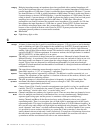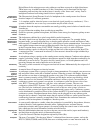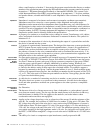
136 Handbook of Intercom Systems Engineering
Earth
British term for a reference ground. Earth may mean power line ground or a facility zero-
reference ground.
Earphone
A device used to hear an electrical audio signal. The earphone converts electrical signals to
acoustic signals that can be heard.
EFP
Electronic Field Production. Production of television programming using field equipment (mobile
trucks, portable gear, et cetera).
EIA
Electronic Industries Association (formerly RMS or RETMA).
EIA Sensitivity
Also called Gm rating. Adding the EIA sensitivity to the SPL at the microphone gives the
microphone power output in dBm into a matched load. Sensitivities for open-circuit can be
considered as follows: -65 dB re 1 volt / microbar = high sensitivity (usually results in better
signal to noise ratio). -75 dB re 1 volt I microbar = medium sensitivity -85 dB re 1 volt / microbar
= low sensitivity.
Electret
Microphone
A microphone using a capacitor as the sound pressure sensing element. Electret microphones are
a special case of condenser microphones in that they are permanently polarized and require no
special polarizing voltage. Electret microphone outputs are high impedance and need to be
buffered by an active device. The active device needs power so various battery, phantom, and A-
B powering schemes are used to buffer the active device, (which is very close to or on the
microphone diaphragm).
Electronic
Switching
versus
Mechanical
Switching
Audio and other signals can be switched either electronically or mechanically. The electronic
switching is generally faster and quieter, but usually has some losses. Mechanical switching is
generally slower, noisier, but has less or little loss. In switching signals from current sources,
electronic switching prevents loss of termination for a significant amount of time.
EMF
Electromotive Force (voltage).
Energy
The capability of doing work.
Energy
Dissipation
Loss of energy by conversion to other forms, usually heat.
ENG
Electronic News Gathering. Accomplished using television and accessory equipment in a small
van, with the capability of relaying pictures and sound back to a broadcast station or network
control center. The equipment used may be of special design, for example smaller “ENG type”
television cameras.
EMI
Electromagnetic Interference. Interference caused by the radiation of electrical or magnetic fields
from sources such as radio transmitters, light dimmers, computers, and transformers.
Equalization
(EQ)
The ability to correct or adjust non-uniform frequency response in a sound system. The
equalization may be applied to a signal to be recorded, that has been previously recorded or to a
real time (“live”) signal.
Equalizer
An electronic device or circuit that allows for the adjustment of a signals frequency response.
F
Farad
A measure of the ability to store electrical charge between two conductors. Farad is named after
Michael Faraday. A capacitance value of one farad can store one coulomb of charge at one volt.
One farad permits one ampere of current when the voltage changes at the rate of one volt per
second. Practical sizes are: millifarad one-thousandth of a farad, microfarad one-millionth of a
farad, nanofarad one-thousandth millionth of a farad, picofarad one-millionth of a millionth of a
farad.
Feedback
1. Audio deliberately fed back to a user, for example a monitor for a musician to hear his own
instrument or voice, 2. Audio feedback to a headset or earset as in IFB operations (see IFB), 3. An
unintentional return of an electrical or acoustic signal to a microphone or amplifier input, the
result of which is an oscillation.
Filter
A circuit that is sensitive to signal frequency and is capable of attenuating some signal
frequencies and not attenuating others.


















